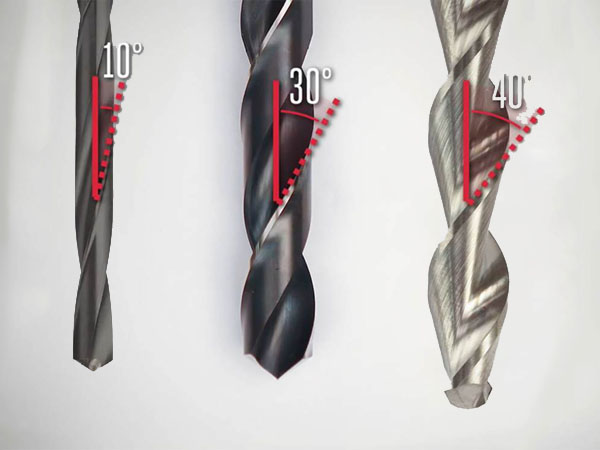
In machine tool hole processing, the spiral angle of the drill bit plays a crucial role in cutting performance, chip removal efficiency, and machining quality. Different spiral angles are suitable for various processing materials and operating conditions.
Larger Spiral Angles (≥30°):
Improve chip flow and removal speed, especially when processing softer materials, reducing the risk of chip accumulation.
Suitable for high cutting speed conditions, minimizing heat accumulation during processing.
Smaller Spiral Angles (≤20°):
For hard materials, smaller spiral angles provide greater cutting force and enhance the cutting stability, effectively preventing vibrations caused by excessive cutting forces.
Larger Spiral Angles: Due to the greater inclination of the cutting edge, cutting forces are distributed more evenly during operation, which helps reduce wear and damage to the drill bit while improving hole surface finish.
Smaller Spiral Angles: Although they concentrate cutting forces, they are suitable for processing hard materials, allowing for controlled cutting speeds and temperatures, thereby extending tool life.
Larger Spiral Angles: Facilitate rapid chip removal and are suitable for larger, shallower holes, but may risk hole enlargement under high loads.
Smaller Spiral Angles: Enhance processing precision, making them suitable for high-precision and deep hole drilling, though they may not perform as well in chip removal.
Choosing the appropriate spiral angle requires consideration of material characteristics, cutting conditions, and desired hole precision:
Soft Materials: For aluminum and copper, a spiral angle greater than 30° is recommended to enhance chip removal capability, with cutting speeds around 100-200 m/min.
Hard Materials: For stainless steel and titanium alloys, it is advisable to select a spiral angle less than 20°, with cutting speeds controlled between 5-25 m/min to ensure stability and precision.
High-Speed Machining: Choose a spiral angle greater than 30° to improve cutting smoothness and reduce frictional heat.
Heavy-Duty Machining: Opt for a smaller spiral angle (15°-20°) to enhance cutting strength and minimize tool wear.
Deep Hole Drilling: Utilize larger spiral angles to ensure good chip removal performance and prevent chip accumulation.
Precision Hole Drilling: Select smaller spiral angles to maintain high precision and avoid deformation of the hole.
Usually we use fixed spiral drill bits, but in some special cases we may use variable spiral drill bits.
The spiral angle of the drill bit plays a key role in hole processing, and selecting the right spiral angle can significantly enhance machining efficiency and improve product quality. By analyzing different materials, cutting conditions, and hole characteristics, valuable guidance can be provided for the design and use of drill bits, achieving optimal machining results.

 We like to do design according to all the customers' requirements, or offer them our new designs. With strong OEM/ODM capabilities, we can fill your sourcing demands.
We like to do design according to all the customers' requirements, or offer them our new designs. With strong OEM/ODM capabilities, we can fill your sourcing demands.